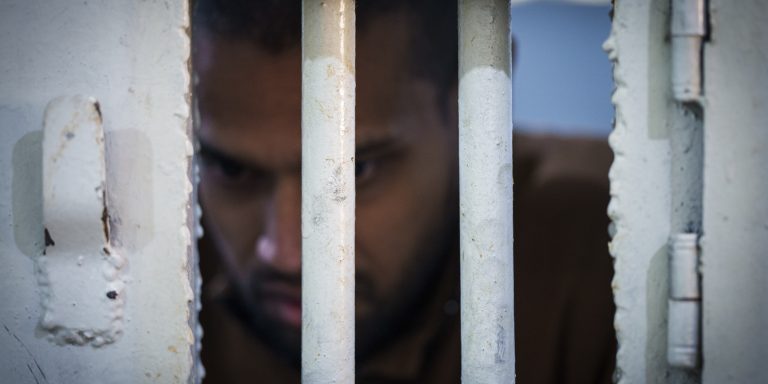
After the fall of Assad, Islamic State fighters capitalized on the ensuing chaos to loot arms depots and ammunition storage sights, replenishing their arsenal and reequipping an insurgent force of several thousand fighters.
Throughout history, insurgents have won simply by not losing, and the Islamic State has consistently demonstrated a knack for survival, biding its time patiently and waiting for the right opportunities before surging again.
Islamic State militants are engaging in mafia-style activities, including extortion and kidnapping for ransom, while preparing for a drawdown in U.S. troops, which most analysts believe is imminent.
Unlike the metaphorical “Black Swan,” which is a rare and unpredictable event, terrorist and insurgent-engineered jailbreaks in Islamic State prison camps and detention centers are better conceptualized as a “gray rhino,” a term that represents a highly probable, high-impact threat that is clearly visible yet consistently neglected.
Nearly a year after longtime Syrian dictator Bashar al-Assad was toppled by Hayat Tahrir al-Sham (HTS), a rebel faction aligned at one point with al-Qaeda, the Islamic State seized upon power vacuums within the country to recruit new members, launch fresh attacks, and destabilize Ahmed al-Sharaa’s nascent government. After the fall of Assad, Islamic State fighters capitalized on the ensuing chaos to loot arms depots and ammunition storage sights, replenishing their arsenal and reequipping an insurgent force of several thousand fighters. During its reign, the Islamic State amassed a fortune of hundreds of millions of dollars and, although its so-called caliphate has been destroyed, its network still likely has access to funding, certainly enough to allow the group to wage a low-level guerilla warfare campaign in perpetuity. Moreover, as it has proven with successful attacks and disrupted plots, the Islamic State is both willing and able to target Damascus directly, demonstrating that it maintains the reach to hit Syria’s capital.
Throughout history, insurgents have won simply by not losing, and the Islamic State has consistently demonstrated a knack for survival, biding its time patiently and waiting for the right opportunities before surging again. The group has also proven remarkably adaptable, surviving despite an aggressive counterterrorism onslaught and outlasting a range of different foes and rivals within Syria and throughout the region. With major powers focused on great power competition, access to critical minerals, and leveraging emerging technologies, including artificial intelligence, the threat posed by the Islamic State has fallen out of focus, with military assets and resources shifted away from counterterrorism and toward other priorities. But the Islamic State remains a potent threat, and in northeastern Syria, the group has conducted more attacks so far this year than it did in all of 2024. The current Syrian government and its security forces are still unable to exert a monopoly on the use of violence throughout the country writ large. There is also friction between Kurdish forces and those loyal to Damascus.
The Islamic State does not control large swaths of territory within Syria as it once did at its apex, however, it operates as a highly capable insurgency where small cells of militants operate in a decentralized manner to conduct hit-and-run attacks, ambushes, and political assassinations against its rivals. Terror cells regularly plant improvised explosive devices that kill and maim members of the Kurdish-led Syrian Democratic Forces (SDF). The Islamic State has resurged throughout eastern and northeastern Syria, including in Deir Ezzor province, where its base of support among the population remains robust. Islamic State militants are engaging in mafia-style activities, including extortion and kidnapping for ransom, while preparing for a drawdown in U.S. troops, which most analysts believe is imminent. The U.S. withdrew approximately 500 troops from Syria over the past six months, and there could be another 500 withdrawn over the next several months, bringing the total to less than 1,000 troops in the country. U.S. intelligence and strike capabilities are indispensable to helping degrade the Islamic State’s leadership. In September, U.S. Central Command (CENTCOM) announced that U.S. forces conducted a raid against an Islamic State high value target “that resulted in the death of a senior ISIS operative who posed a direct threat to the U.S. homeland.” Even as most of the world has shifted its attention elsewhere, Islamic State terrorists continue to plot external operations in the West, including those aimed at killing Americans on U.S. soil.
Islamic State propaganda routinely highlights the looming threat of prison breaks. Thousands of Islamic State fighters and tens of thousands of their family members remain in prisons and detention centers throughout Syria, which are guarded by Kurdish militias that are already overstretched and undermanned. Numerous countries refuse to bring back their citizens, instead leaving them to languish in disease-infested detention camps where the next generation of the Islamic State is being raised. Unlike the metaphorical “Black Swan,” which is a rare and unpredictable event, terrorist and insurgent-engineered jailbreaks in Islamic State prison camps and detention centers are better conceptualized as a “gray rhino,” a term popularized by author Michele Wucker, that represents a highly probable, high-impact threat that is clearly visible yet consistently neglected. In the past, the Islamic State has waged what it called a “Breaking the Walls” campaign, in which it deliberately sought to engineer prison breaks to free its fighters and reabsorb them into the organization. In January 2022 in Hasakah, the Islamic State launched a complex operation to free jailed militants. Successful prison break operations not only help reinforce the group’s ranks, but they also serve as a bonanza for the group’s propaganda and information campaigns.
The Islamic State is also fairly unique when it comes to transnational terrorist organizations. The group maintains a global network of franchises and regional branches that, even while their approach is tailored to local contexts, remains loyal to a shared ideology and driving motivation. While in the past Islamic State core or Islamic State central, anchored in Iraq and Syria, might push resources to the outstations, the situation is now reversed in some ways, as Islamic State affiliates in sub-Saharan Africa or South Asia have the bandwidth to send resources back to the group’s fighters in the Levant. The General Directorate of Provinces has emerged as an extremely important decision-making node for the organization, while other components, including the al-Karrar Office, linked to the Islamic State’s operations in Somalia, plays an increasingly crucial logistical and facilitative role.
